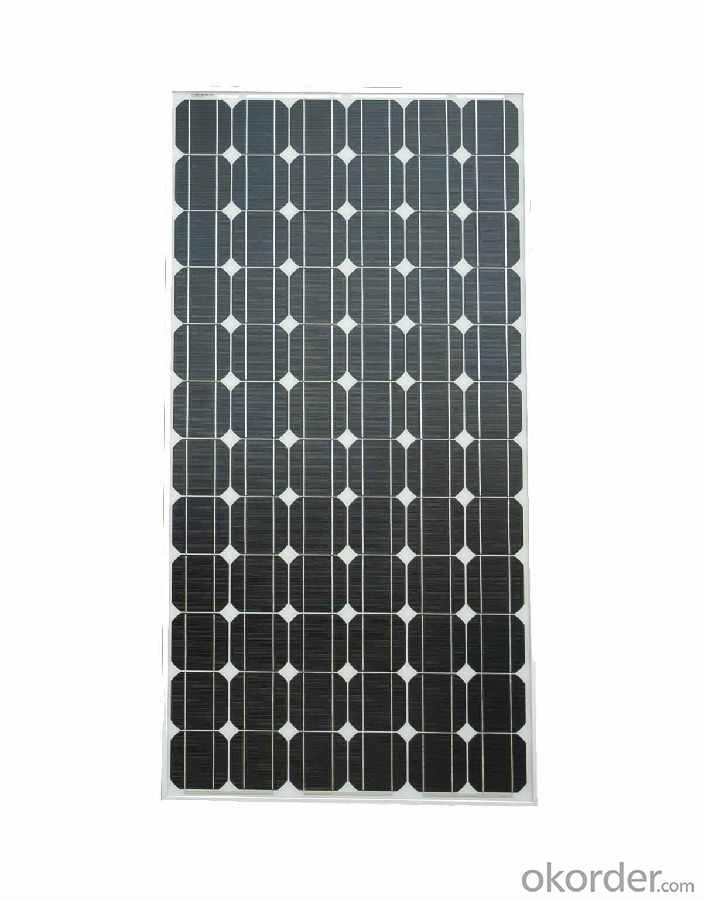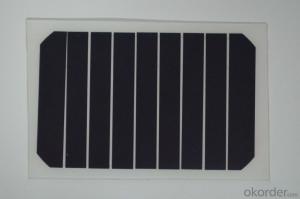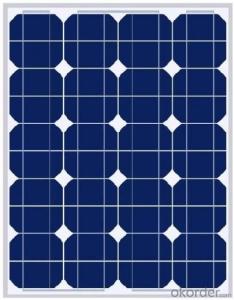Small Monocrystalline Solar Panel with 3W Power CNBM
- Loading Port:
- Qingdao
- Payment Terms:
- TT OR LC
- Min Order Qty:
- 10 set
- Supply Capability:
- 300000 set/month
OKorder Service Pledge
OKorder Financial Service
You Might Also Like
Small Monocrystalline Solar Panel with 3W Power

Quick Details
Place of Origin: | China (Mainland) | Brand Name: | CNBM | Model Number: | XRP-156M-250W |
Material: | Monocrystalline Silicon | Size: | 1620x992x40mm | Number of Cells: | 60 |
Max. Power: | 250w | Optimum Operating Voltage (Vmp): | 28.8V | Optimum Operating Current (Imp): | 8.68A |
Open Circuit Voltage (Voc): | 36V | Short Circuit Current (Isc): | 8.87A | Maximum Power at STC (Pmax): | 250W |
Operating Module Temperature: | -40 °C to +85 °C | Maximum System Voltage: | 1000 V DC (IEC) / 600V DC (UL) | Maximum Series Fuse Rating: | 15A |
Packaging & Delivery
Delivery Detail: | two weeks after order confirmation |
Features:
1) High Module conversion efficiency, through superior manufacturing technology
2) 0 to +5W positive tolerance for mainstream products
3) Certified to withstand high wind loads and snow loads
4) Anodized aluminum is for improving corrosion resistance
5) Anti-reflective, Highly transparent, low iron tempered glass
6) Excellent performance under low light environment
Benefit:
25-year performance warrant
10-year Product warranty
Electrical Characteristics:
Item No. | XRM-250W |
Optimum Operating Voltage (Vmp) | 28.8V |
Optimum Operating Current (Imp) | 8.68A |
Open Circuit Voltage (Voc) | 36V |
Short Circuit Current (Isc) | 8.87A |
Maximum Power at STC (Pmax) | 250W |
Cell Efficiency | 17.70% |
Operating Module Temperature | -40 °C to +85 °C |
Maximum System Voltage | 1000 V DC (IEC) / 600V DC (UL) |
Maximum Series Fuse Rating | 15A |
Power Tolerance | 0/+5 % |
STC: lrradiance 1000 W/m2, module temperature 25 °C, AM=1.5;
Best in Class AAA solar simulator (IEC 60904-9) used, power measurement uncertainty is within +/- 3%
Mechanical Characteristics:
No. of Cells | 60(6X10) |
Dimensions | 1640x992x40MM |
Weight | 20.0KGS |
Front | Glass 4.0 mm tempered glass |
Frame | Anodized aluminium alloy |
Temperature Characteristics:
Nominal Operating Cell Temperature (NOCT) | 45±2°C |
Temperature Coefficient of Pmax | -0.44 %/°C |
Temperature Coefficient of Voc | -0.33 %/°C |
Temperature Coefficient of Isc | 0.055 %/°C |
Refer to the Wmp range
Our factory can produce solar panel and solar module from 1.5W-290w (1.5w, 2.5w, 5w, 10w, 20w, 40w, 50w, 60w, 80w, 85w, 125w, 135w, 150w, 165w, 180w), according to customers requirement.
(A). Wmp range: 0.01W-6W, to be sealed with epoxy resin on PCB (printed circuit board), or to be sealed in plastic directly.
(B). Wmp range: 0.01W-15W, to be encapsulated with PET, on PCB (printed circuit board)
(C). Wmp range: 1W-60W, to be encapsulated with PET, on stainless steel, with holes for assembling purpose.
(D). Wmp range: 1W-290W, to be encapsulated with tempered glass, EVA, TPT, together with aluminium frame, junction box and (if necessary)diode and cable.
Refer to the material:
Monocrystalline solar cell or polycrystalline solar cell
Efficiency range 14%-17%, cell size 5/6.
- Q:How do solar panels impact the roofing material's lifespan?
- Solar panels can actually extend the lifespan of roofing materials. This is because they provide protection against various weather conditions, such as rain, sun, and snow, which can cause damage to the roof over time. Additionally, solar panels act as a shield, preventing direct exposure to harmful UV rays that can deteriorate roofing materials.
- Q:What is the impact of dust and dirt on solar panels' efficiency?
- Dust and dirt on solar panels can significantly reduce their efficiency. When these particles accumulate on the surface of the panels, they block sunlight from reaching the photovoltaic cells, resulting in decreased energy production. Regular cleaning and maintenance of solar panels are crucial to ensure optimal performance and maximize their power output.
- Q:I have 2 20 watt Solar panel. I have it hooked up to solar controller and batteries to inverter. Am trying to figure out how much watts am getting. I found the voltage but how do I find the amp reading on a mutimeter?
- While you can measure voltage on a like without a load, the measure of amperage is more closely related to the amount of power that is being drawn. The amperage is measured with the meter in series (not parallel like voltage) with the load. What it ends up measuring is the load that is being drawn from the solar panel and not the potential of the panel.
- Q:I have 2 solar panels one is 5 watts 2 volts .2 amps or -The other is 50 watts 2 volts 2.6 amps or-Can I ...and what is the best way to hook them togeather to increase my amps being put back to my battery ?? I would be hooking them up to a 7 amp 00 watt charge controllerThe panels are rated 2 volt but the specs say they will produce more whennot connected to charge controllerPlease advise and should I even bother with the smaller panel ?
- The answer is that the two panels should be put in parallel. The voltage out will drop to the voltage of the lower panel, but you should get most of the power, if the panels aren't too badly mismatched. I would try to get a multimeter and try to measure the actual current coming out of the panels in full sun. Sometimes the specifications on these smaller panels are very optimistic. If the whole setup is putting out less than 2 amps, I'd say wire the whole thing straight to the battery - little chance of boiling the electrolyte at those currents.
- Q:This is the cenario. Your yearly energy use comes by mail and it states that the total amount of energy used your household is 7000kWh.Then you make the decision of switching to get solar panels. The question is what area should your solar panel be given that the average annual length of daylight is 2.0.
- It is not that simple. There are 3 main types of solar cells. Monocrystalline silicon is the most efficient and produces the smallest solar cells, and therefore the smallest panels. Poly-crystalline (or multi-crystalline) silicon produces the next most efficient type of cells and are a popular choice. Amorphous (or thin-film) silicon uses the least amount of silicon and also produces the least efficient solar cells. This means thin film system take up more area than the other two; an important factor to consider in relation to possible future upgrades; i.e. if you'll have enough space left to do so. The North (in the Southern hemisphere) or South (in the Northern hemisphere) facing roof collects the most energy. So this biases the roof area required. Your energy usage can be changed. Hot water (a major energy user) could be better using direct solar heating with peak demand boosting, either from mains or solar. There are other possibilities, either to reduce demand or to provide energy from other sources. Not all sunshine hours are equal. Hours around midday are far more productive than hours later in the day. This must be factored in.
- Q:my pool guy cleaned the filter and replaced the DE, but now my roof solar panels have started leaking. how do i stop the leak? does backwashing help in any way?
- If you do not isolate the solar system when backwashing your filter, you WILL pump DE into the panels and plug them and destroy them. At this point you may have to disconnect the panels, wash them from the RETURN SIDE (from the higher pipe and HOPE that the DE will flow out of the panels... most likely your pool guy just screwed up your solar real good... if the DE is plugging your panels, when winter comes your panels will split because they are holding water and the freezing water will split them... I hope your pool guy has insurance
- Q:Can solar panels be used in multi-story buildings?
- Yes, solar panels can be used in multi-story buildings. They can be installed on the roof of the building or on vertical surfaces such as walls or balconies. The availability of space and the structural integrity of the building are important factors to consider when installing solar panels in multi-story buildings.
- Q:Installing solar panels requires a big initial investment. Before I make this investment I want to check to see if the money I will save by installing solar panels will actually pay for this investment, in the long run. To calculate my savings, we should consider the area (square feet) I currently have available to install solar panels. Look at the available sunlight and its intensity in my state each month of the year. Based on this data estimate how much energy my solar panel will generate. Then compare that with how much energy (kWh) I currently consume based on my electricity bill.
- Only by doing the calculations (figuring out how much you electricity bill is per month now and calculate how much time it will take to get to the figure of your solar panels. Don't forget to add a couple of percentage points per year higher(since when has electrical costs gone down)? and do the addition. That is when you will pay off the solar panels, as their power is free.
- Q:Me and my wife just saw an ad on TV about going solar and saw the money we can save every month... any here have solar panels? How much do you save every month on energy bill? Is it true that your energy meter will spin backwards? lol
- You okorder The notion of spinning a meter backward has a lot of people plugging in their solar panel via an inverter- but this is a very bad idea and illegal as well- the power company requires a lockout device they control to kill power in their powlines for servicing and repairs- a plugged in solar panel and inverter can cause them injury or death. If you have about 30,000 dollars to invest (cost will vary), and you are going to be staying in your home for at least 0 years, contact your electric power utility as they will have the progams in place to do the installation on your site, and install the needed equipment for you to be legally grid tied. They will also have your paperwork prepared for your tax person come tax time. Most are actually seeking people out to do this, I won't go into details why, but by listening carefully to the power company in their presentation they will indirectly tell you why. Any installation that is intended to be grid tied MUST be approved by the power company and meet their specifications. Too many people are ignoring this last detail.
- Q:How efficient are solar panels when it comes to turning light into energy? If it's not 00%, why? Can it be improved? Also, how do solar panels work, exactly.
- Solar panels are 5-30% efficient in turning light into energy. I'm not sure why it isn't 00%, but methods are constantly improving, and the panels are getting more efficient with time and research. Solar panels work with photovoltaic (PV) cells, which are made up of two very thin layers of semiconductor with a middle junction layer. The kinetic energy in light photons create a current that flows into whatever electrical cord it is attached to.
1. Manufacturer Overview |
|
|---|---|
| Location | |
| Year Established | |
| Annual Output Value | |
| Main Markets | |
| Company Certifications | |
2. Manufacturer Certificates |
|
|---|---|
| a) Certification Name | |
| Range | |
| Reference | |
| Validity Period | |
3. Manufacturer Capability |
|
|---|---|
| a)Trade Capacity | |
| Nearest Port | |
| Export Percentage | |
| No.of Employees in Trade Department | |
| Language Spoken: | |
| b)Factory Information | |
| Factory Size: | |
| No. of Production Lines | |
| Contract Manufacturing | |
| Product Price Range | |
Send your message to us
Small Monocrystalline Solar Panel with 3W Power CNBM
- Loading Port:
- Qingdao
- Payment Terms:
- TT OR LC
- Min Order Qty:
- 10 set
- Supply Capability:
- 300000 set/month
OKorder Service Pledge
OKorder Financial Service
Similar products
New products
Hot products
Related keywords




























